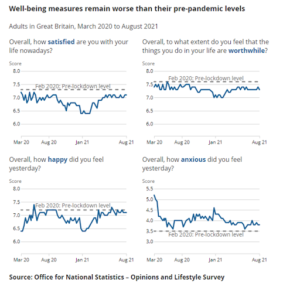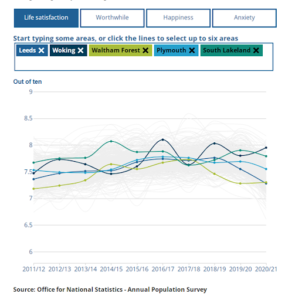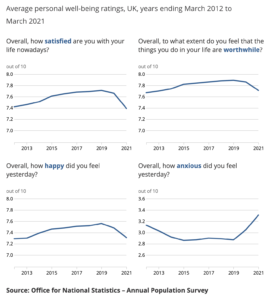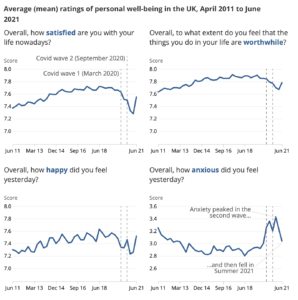The Office for National Statistics collects data on personal subjective wellbeing in the UK and has done since 2011/12. This gives us good population-level data on ‘how people are doing’ across the UK over time.
What happened to our personal wellbeing during the pandemic and has it recovered? Nancy Hey takes us through what the data tells us…
Pandemic hit – March 2020
We can clearly see the immediate impact of the pandemic in March 2020 and how it compares to the previous 10 years of data. Quarter 2 of 2020 saw the highest average rating of anxiety recorded since 2011 – a 12.5% increase – driven by a big increase in the numbers of people reporting high anxiety.
What happened next – June 2021
The data to June 2021 shows that the lows in the first two waves of the pandemic were some of the lowest recorded, but that people were starting to recover. This is what we’d expect – we don’t like change but adapt to most things. It’s also why changes might not be captured in one-off annual surveys and why we should focus on big impacts and where we don’t bounce back e.g. unemployment or making sure increases in severe loneliness don’t become long term.
Our analysis
At the What Works Centre for Wellbeing, we looked at the impact of the pandemic on subjective wellbeing disparities, and how it affected people of different different ages, sex and employment status. We found:
- That the male:female life satisfaction gap (men lower life satisfaction) has reduced over the last ten years but the anxiety gap (women more anxiety) has increased.
- 20-24 year olds are experiencing high anxiety and a big drop in happiness (although not the lowest). This is one of the few age groups to see a worsening of anxiety over the last ten years as well as during the pandemic and hasn’t ‘bounced back’ from the pandemic impact either.
- 25-29 year olds have seen the biggest pandemic bounce-back and 30 somethings generally reporting more stable levels of all measures.
- Mid-life continues to see the lowest life satisfaction and happiness.
- 65-75 year olds report the highest on all measures until purpose drops away from age 85.
How are we doing now?
During the pandemic, the ONS published weekly data from its Opinion and Lifestyle survey. This data isn’t as detailed but it is faster and has been largely confirmed by the more robust quarterly data releases as above.
The happiness data has been the fastest to return to its ‘pre-pandemic’ levels. Positive emotion is an important buffer against difficult circumstances and helps us to cope better with challenges. See more research that we carried out on how we coped (or not) with the pandemic.

The latest information on our subjective wellbeing is here. We are able to compare this Christmas period to the same period in 2021 where anxiety was a little lower but life satisfaction, purpose and happiness all lower.
It is also possible to see the trends in the data over the last ten years for every local authority in the UK.

What are the ONS personal subjective wellbeing measures?
The measures consist of four harmonised quality of life questions covering the main aspects of the concept:
- Evaluative or Cognitive: Life Satisfaction
- Eudaemonia or Purpose: Worthwhile
- Positive affect or mood: Happiness
- Negative affect or mood: Anxiety
These four different measures are closely related as you’d expect, but do change at different speeds and in response to different things. For example:
- Life satisfaction is very good for picking up work, relationships and health together and is the foundation of the HMT Valuation of Wellbeing Guidance, which gives agreed effect sizes for these well known impacts – see more on life events.
- We recently looked at the drivers of purpose and you can see the importance of looking after the home, volunteering, working in the VCSE sector and religion in protecting our wellbeing.
- The ‘affect’, or experience, measures change most rapidly and are important in our culture and sport work for example.
All are important for our overall wellbeing now and in the future. You can see our methods series discussions, measures bank and workplace wellbeing questionnaire to learn more.



